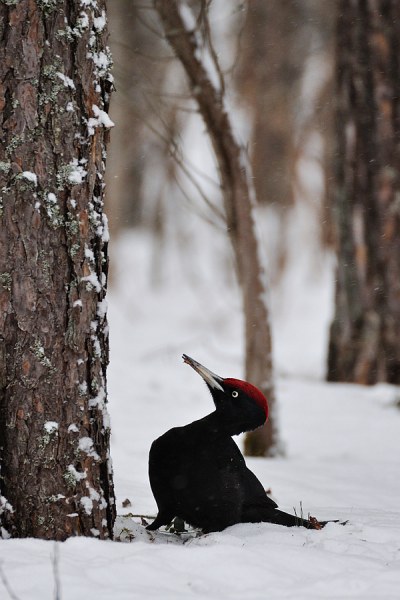Walking woodpecker
Text and photo Rein Kuresoo, animalcity.eu/kuresoo/
Translation: Liis
Black woodpecker Musträhn Dryocopus martius
Spring has got caught up somewhere beyond the blue-shimmering forests. Despite this the sun immutably does its everyday work – without any particular ardour but as compensation with the precision of a Finnish sniper. Just give the sun a dark spot – the day starts at once to heat it. The sun frees the feet of saplings and trees, warms the southern sides of tree trunks, and heats every speck spilled on the white snow down through the cover.
At the feet of the trees insects wake up and clamber out of their sleeping bags – they stretch their feet, move their jaws, rub their eyes, scratch their behinds and by and by come to peek at what wonders there are to be seen in the world. But no particular wonders are to be seen yet, only the black woodpecker in its splendid stationmaster’s uniform has been waiting for them already and jumps down from the tree crown. As a rule the woodpecker is not a walking man in the forest, the black woodpecker and the green woodpecker however do it (true, the walks of the green woodpecker in Estonia seem to have been walked to an end). The black woodpecker likes to eat the horse ants that are busy at tree stumps and the feet of trees. What is the woodpecker, busy in the photo above, eating? The horse ants were not born yesterday, they will not let themselves be fooled by the first caress of the sun. To get at them the woodpecker at present would have to hack large holes at the root, but it rather rummages around in the moss close to the trunk and now and then grabs someone from the tree trunk. When the black bird has done its work it flies, shrilly calling, into the forest. Then I too can take a look at whether anything edible is left at the foot of the tree. The most numerous pests of pines are the European pine sawfly (Neodiprion sertifer) and the web spinning pine sawfly (Acantholydaposticalis). The grubs scramble down the pine trunk in autumn, in early spring new imagos are hatched from the pupae of both. But my eyes discern nothing in the moss, and I have no reading glasses with me. But if you look the black woodpecker straight in the eye then quite a few interesting things appear – instead of a round pupil it has an oval, but sometimes also a pear-shaped pupil – just as if the woodpecker should have slightly awry contact lenses. If the creationists should become aware of this fact too, they would have one more trump on hand against the Darwinists in addition to the construction of the woodpecker’s tongue. One walk in the forest – many questions, few answers. But so it is with woodpeckers.









